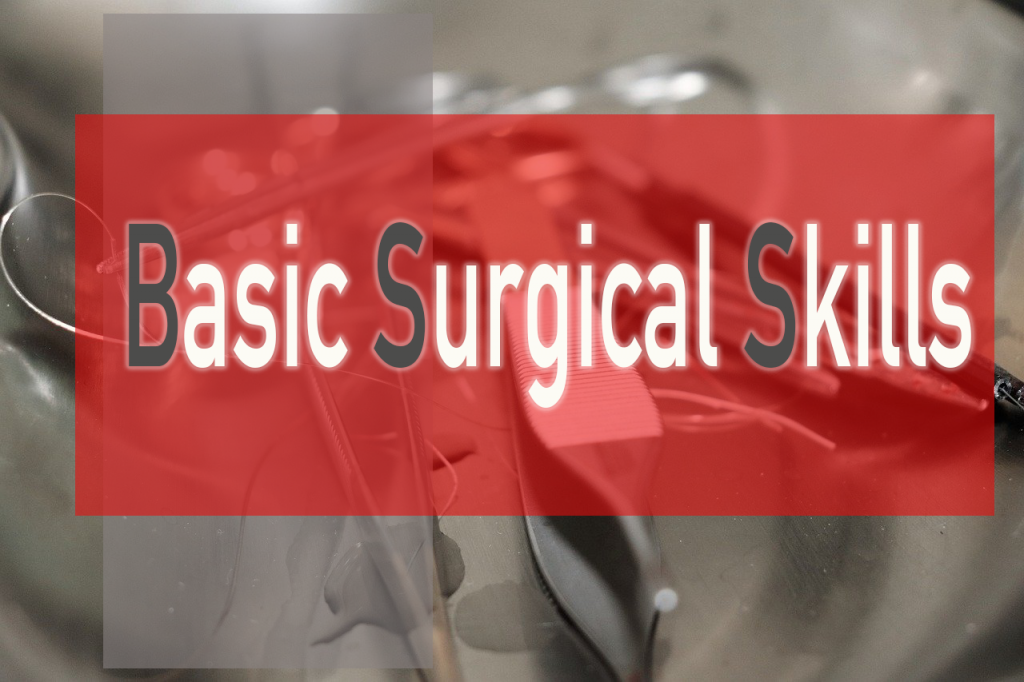Skill Group: Clinical Skills
Basic Instrument Handling
This skill is part of the skill unit: Clinical Skills

Lab Goal
To introduce students to the basic surgical instrumentation that they will need for simple surgical tasks in their veterinary career. To teach students how to handle basic instruments before they learn poor habits in other curricular and clinical activities.
Introduction
Basic instrument handling is an essential skill used daily in any kind of veterinary practice. Incorrect handling results in inefficient or unsafe technique.
Essential skills include how to: load and unload a scalpel blade on a handle; hold scissors and needle drivers with a tripod grip; use thumb forceps correctly; make an incision; hold a scalpel correctly; load suture onto needle drivers; tie a square and surgeon’s knot; tie simple interrupted sutures.
Knowledge components include understanding: parts of instruments; names of instruments; instrument handling techniques; knot tying and types of knots.
An instructor will demonstrate the recommended techniques and then the students will have an opportunity to practice them with assistance from circulating clinical faculty and staff members.
Once these skills are mastered, students will be able to progress into more advanced skills, such as: passing instruments to a surgeon/assistant; performing simple continuous suture pattern; apply skin suturing patterns.
Learning Outcomes
By the end of this module, you should be able to:
- Identify basic instruments and parts of instruments (scalpel blade and handle, needle drivers, thumb forceps, mayo scissors, Metzenbaum scissors, operating scissors, needle, suture)
- Safely load and unload a scalpel blade onto a scalpel handle, make incisions using palm (fingertip) grip, pencil grip, and stab incision.
- Correctly remove suture from the package, hold scissors and needle holders using a tripod grip, correctly use thumb forceps.
- Place simple interrupted sutures using instruments, tie a square knot using instruments, tie a surgeon’s knot and know when it is needed.
- Operate safely and in an organized manner.
Module Roadmap
To successfully complete this module, we recommend that you review the following lessons in order:
Materials Need for the lab
List of Materials Provided by the Students:
Bring your tablet as there are a number of checklists that will help you stay in task and successfully complete self + peer evaluation. Refer to the lab contract for dress code. Permanent supplies – each student will receive a “Skills Kit” at the beginning of the semester, will keep their kit to practice skills at home. Please bring your “Skills Kit” to every lab required. Each Skills Kit includes:
- 1)Scalpel handles #3
- 2)Mayo-Hegar needle holders
- 3)Brown-Adson thumb forceps
- 4)Operating scissors (also called suture scissors, or blunt-sharp)
- 5)Simulated skin Sharps –
Consumable supplies :
- 1)Scalpel blades #10
- 2)3 packs of 2-0 silk suture with swedged-on needles (reuse if enough is left)
- a. One suture pack will be used during the lab and the remaining suture packs should be used for additional practice at home or in the VCPSC.
List of Materials Provided by the VCPSC:
Permanent supplies – these can be found in a disinfecting bath at the beginning of each lab and should be placed back into the disinfecting bath so it is ready to be used by the next student group: Each student will work with:
- 1)Scalpel handles #4
- 2) Olsen-Hegar needle holders
- 3)Rat-tooth thumb forceps
- 4 )DeBakey thumb forceps
- 5)Mayo scissors
- 6)Metzenbaum scissors
- 7)Biohazard or sharps containers